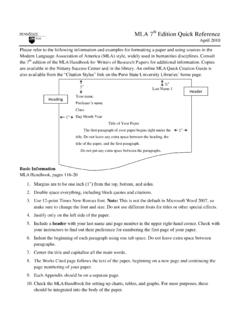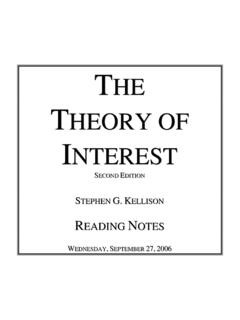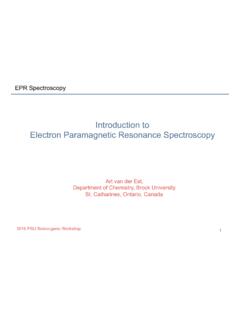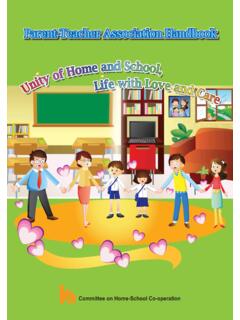Transcription of Pocket Guide to Simple Art Assessments - WordPress
1 The Pocket Guide to Simple Art Assessments 10 Quick, Simple and Easy ideas to get you motivated to try new Assessments in the art classroom. The Pocket Guide is a a sampling from the The Complete Guide to Simple Art Assessments - Like what you see? Download the entire, 65 page book for only $9 and watch yourself become an assessment guru overnight! Feel free to pass along and share this completely FREE E-Book, but please give credit where credit is due. Always include a link to if you share this information in any way in print or online. Please note that much of this publication is based on personal experience and anecdotal evidence. Although the author has made every reasonable attempt to achieve complete accuracy of the content in this Guide , they assume no responsibility for errors or omissions.
2 Copyright 2012 Jessica Balsley, The Art of Education, LLC. About Jessica My name is Jessica Balsley, I teach K-5 Art and am a leader in my district as the coordinator and facilitator of the Art Department. I founded The Art of Education because I was underwhelmed with the quality of resources out there for art teachers, especially the ability to take classes in the field without driving long distances. Because of this frustration, I created AOE which is a unique hybrid of professional development opportunities, tips and tricks just for art educators, online graduate level classes, and much more. My scope goes beyond simply art education. I am passionate about helping art teachers improve their lives, work/home balance, teaching strategies, management, professional development, attitudes and a thousand other things you won't find on the average art education blog or website.
3 With this unique background and perspective in art, education and leadership, AOE provides a well rounded perspective on the manny facets of this profession. Art educators need quality professional development, and I hope to provide that through the resources found on AOE. Questions or Comments? I'd love to hear from you! Email me at 1. Verb's the Word! Using good questioning techniques is important when thinking about arts assessment. When asking an assessment question, here are 4 verbs or starter phrases you can't live without to ask a good question that gets beyond basic fact recall. Explain Explain to me how Monet's brush strokes differ from those of Seurat . Describe Describe the process an artist might use to create a coil pot . Why Why did you choose to use warm colors in the sky?
4 What What if I chose to use zigzag lines instead of straight lines in this work? How would it change the meaning of the piece? A detailed tutorial to writing better, higher order assessment questions can be found in the Complete Guide .. 2. Wagon Wheels A Wagon Wheel is a formative assessment you can use to help students become more comfortable talking about their artwork, using art vocabulary and build confidence in the art room. Formative Assessments should be quick and Simple and give you an idea of what your students know in order to inform your instruction. I include an entire chapter on formative Assessments with tons of examples in the Complete Guide .. Wagon Wheel Help students facilitate feedback to other students What's a Wagon Wheel? Arrange students in 2 large circles, one circle inside the other.
5 Each student should have one piece of art in his or her hands. A student on the inside circle lines up with a student on the outside circle. Pairs share discussion about their art (facilitated by the teacher) and then the outside wheel rotates, giving students a new partner. Your role during this process is to listen for student understanding through their conversations and gauge where each student is at in the learning process. This really gets students comfortable talking about their artwork in a structured setting. 3. Labeling Use Sticky Notes to Label art concepts! Labeling Have students label where they used warm, cool and neutral colors using a sticky note directly on their artwork. Arrows or multiple stickies may help with this. Have students write 3 facts about an artist on a sticky note on the back of the You get the idea!
6 The possibilities are endless when it comes to uses for sticky notes in the art room. You can check for understanding at the same time you grade the artwork and remove the sticky note after you have graded it. Easy, Simple and you can do double duty when grading both visual and content related art concepts. I've devoted an entire section of the Assessment in Art Education class online for art teachers to Formative Assessments just like this one, where you can create your own and take ideas from classmates as well (yes stealing is permitted!). 4. Teacher Feedback Teacher feedback is an important type of assessment - even more important then grading! How have you set up and organized your grading in order to have success with the time consuming task of giving students personalized comments?
7 Even though it can take you more time to give comments on the back of artwork, research has proven that students are more likely to take a personalized comment to heart and improve than a Simple grade or letter. To help you, I suggest a pre-formatted template like the one below. Want to download full sheets of blank printables just like these?..you can find them in the Complete Guide .. From your Mrs. Balsley WOW!! : I can see 5 different values in your still life- great job! Keep working hard at: your craftsmanship - don't rush 5. Student Self-Reflection 2 Stars and a Wish The 2 Stars are things you are proud of about your artwork. The wish is something you Wish you could improve upon or a goal for next time. 2 Stars and a Wish My painting was very neat and tidy! I used warm colors in the sky to make the sunset.
8 I wish I had spent more time on the details in the boat. Download the entire blank template of this assessment in the Complete Guide and put it to immediate use in your classroom 6. Make a Checklist Name 3 artists you learned about. Tell me more about them! What process did you use to create this piece? If you could do this again, what would you change? You can use checklists for just about anything in the art room when it comes to assessment. This checklist can help students reflect on their own art work or help parents facilitate art conversations with students. Checklists can help students organize their portfolios or even help you grade artwork instead of a rubric. I like checklists because they are Simple but effective in getting the job done! And doesn't it feel good to check something off a list?
9 Sure does! 7. Short Answer If you don't have time for a large performance based assessment, Short Answer is a great alternative. It allows you to get inside the head of the student and understand their thinking and knowledge of the concepts. It also allows students to use interdisciplinary connections to literacy in order to express themselves through writing and art. There are two more types of assessment questions besides short answer I think are really important. I will go into great detail in the Assessment in Art Education class giving you TONS of samples to take with you as you form your own amazing assessment plan for your students. Explain the process an artist might use to create a 6. hue color wheel, starting with the 3 primary 8. Labeling In the box below make a quick sketch of your clay project.
10 Please label using arrows where you will use the the slip and score method to attach the clay together. Labeling is a great technique because it's visual. I especially like labeling as students are planning their artwork. This will show you, the teacher, students are ready for the art concept and understand the foundational material before they start to work. Hopefully it will make the creation process much more smoothly. 9. Portfolio As Advocacy Have you ever thought of using a Portfolio not only to assess student work, but as an advocacy tool for parent/teacher connections? When you send home portfolios think of including the following with the artwork: Checklists to show the contents of the portfolio to help parents better understand what was achieved in the art room Parent questionnaire to be sent back with the student Teacher feedback forms to parents can see what students are doing well and needing improvement on.














